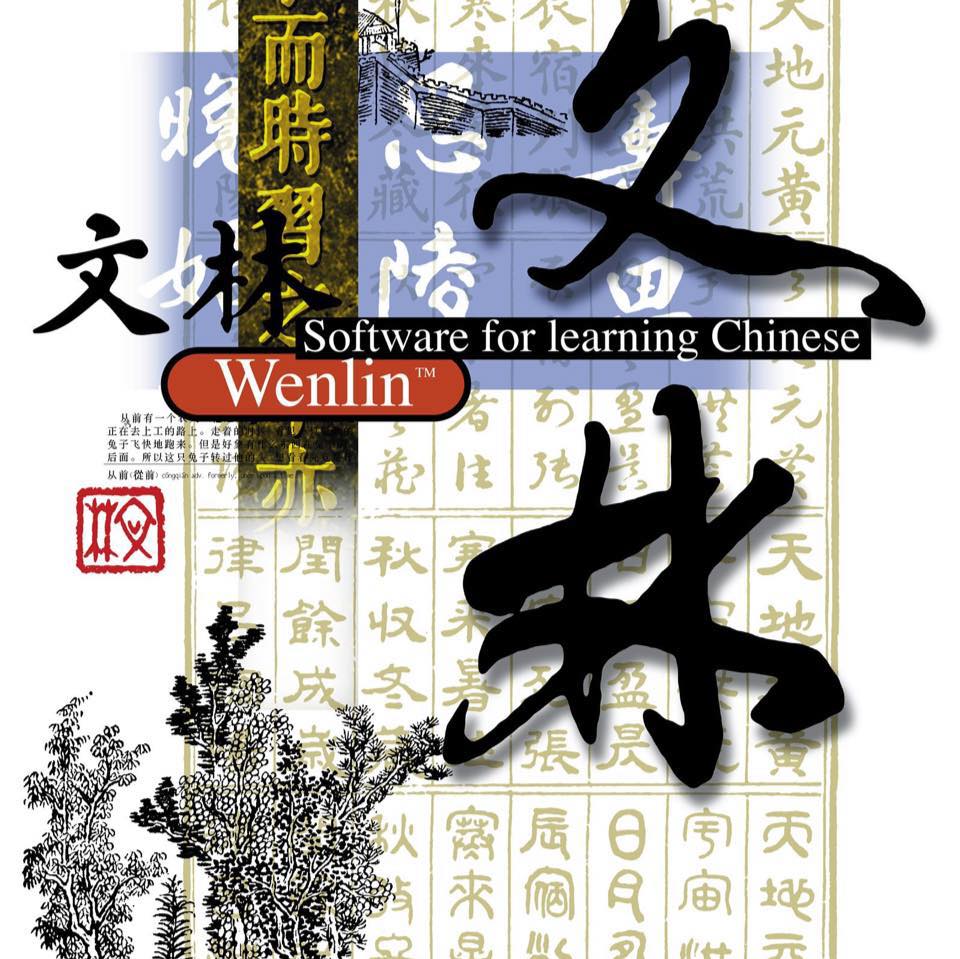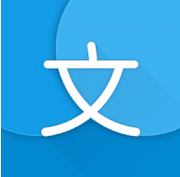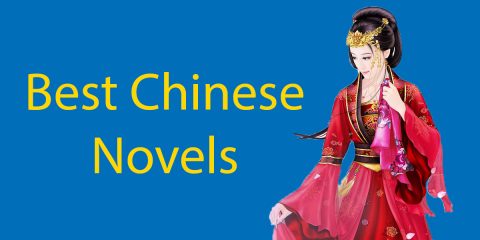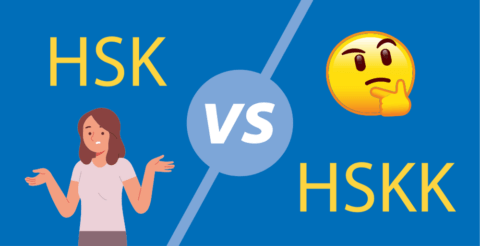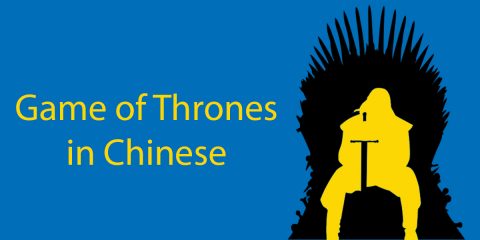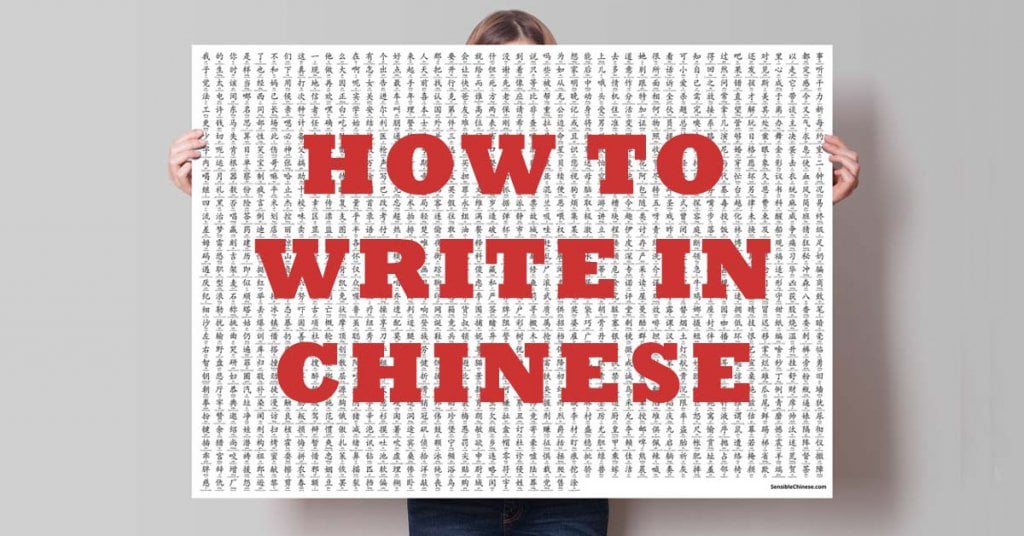
You probably think learning how to write in Chinese is impossible.
And I get it.
I’m a native English speaker, and I know how complex Chinese characters seem.
But you’re about to learn that it’s not impossible.
I’ve teamed up with Kyle Balmer from Sensible Chinese to show you how you can learn the basic building blocks of the Chinese written language, and build your Chinese vocabulary quickly.
First, you’ll learn the basics of how the Chinese written language is constructed. Then, you’ll get a step-by-step guide for how to write Chinese characters sensibly and systematically.
Wondering how it can be so easy?
Then let’s get into it.
Don’t have time to read this now? Click here to download a free PDF of the article
By the way, if you want to learn Chinese fast and have fun, my top recommendation is Chinese Uncovered which teaches you through StoryLearning®.
With Chinese Uncovered you’ll use my unique StoryLearning® method to learn Chinese through story… not rules.
It’s as fun as it is effective.
If you’re ready to get started, click here for a 7-day FREE trial.
How To Write In Chinese
Chinese is a complex language with many dialects and varieties.
Before we dive into learning to write Chinese characters, let’s just take a second to be clear exactly what we’ll be talking about.
First, you’ll be learning about Mandarin Chinese, the “standard” dialect. There are 5 main groups of dialects and perhaps 200 individual dialects in China & Taiwan. Mandarin Chinese is the “standard” used in Beijing and spoken or understood, by 2/3 of the population.
Second, there are two types of Chinese characters: Traditional and Simplified. In this article, we’ll be talking about Simplified Chinese characters, which are used in the majority of Mainland China.
There is an ongoing politicised debate about the two kinds of characters, and those asking themselves: “Should I learn traditional or simplified Chinese characters?” can face a difficult choice.
- For more on difference between Simplified and Traditional characters read this article
- To learn more about “the debate” read this excellent Wikipedia article
- If you want to switch Simplified characters into Traditional, you might like the fantastic New Tong Wen Tang browser plugin
First Steps in Learning Chinese Characters
When learning a European language, you have certain reference points that give you a head start.
If you’re learning French and see the word l’hotel, for example, you can take a pretty good guess what it means! You have a shared alphabet and shared word roots to fall back on.
In Chinese this is not the case.
When you’re just starting out, every sound, character, and word seems new and unique. Learning to read Chinese characters can feel like learning a whole set of completely illogical, unconnected “squiggles”!
The most commonly-taught method for learning to read and write these “squiggles” is rote learning.
Just write them again and again and practise until they stick in your brain and your hand remembers how to write them! This is an outdated approach, much like reciting multiplication tables until they “stick”.
I learnt this way.
Most Chinese learners learnt this way.
It’s painful…and sadly discourages a lot of learners.
However, there is a better way.
Even without any common reference points between Chinese and English, the secret is to use the basic building blocks of Chinese, and use those building blocks as reference points from which to grow your knowledge of written Chinese.
This article will:
- Outline the different levels of structure inherent in Chinese characters
- Show you how to build your own reference points from scratch
- Demonstrate how to build up gradually without feeling overwhelmed
The Structure Of Written Chinese
The basic structure of written Chinese is as follows:
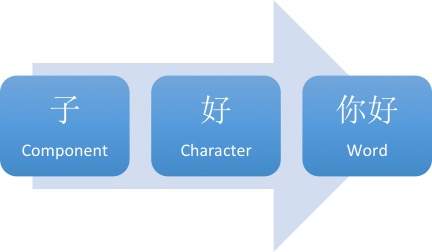
I like to think of Chinese like Lego... it’s very “square”!
The individual bricks are the components (a.k.a radicals).
We start to snap these components together to get something larger – the characters.
We can then snap characters together in order to make Chinese words.
Here’s the really cool part about Chinese: Each of these pieces, at every level, has meaning.
The component, the character, the word… they all have meaning.
This is different to a European language, where the “pieces” used to make up words are letters.
Letters by themselves don’t normally have meaning and when we start to clip letters together we are shaping a sound rather than connecting little pieces of meaning. This is a powerful difference that comes into play later when we are learning vocabulary.
Let’s look at the diagram again.

Here we start with the component 子. This has the meaning of “child/infant”.
The character 好 (“good”) is the next level. Look on the right of the character and you’ll see 子. We would say that 子 is a component of 好.
Now look at the full word 你好 (“Hello”). Notice that the 子 is still there.
- The character 好 is built of the components 女 and 子.
- The character 你 is built from 人 + 尔.
- The word 你好 in turn is constructed out of 你 + 好.
Here’s the complete breakdown of that word in an easy-to-read diagram:
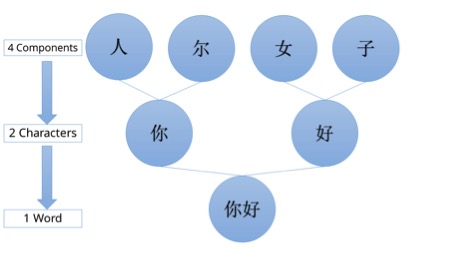
Now look at this photo of this in real life!
Don’t worry if you can’t understand it. Just look for some shapes that you have seen before.

The font is a little funky, so here are the typed characters: 好孩子
What components have you seen before?
Did you spot them?

This is a big deal.
Here’s why…
Why Character Components Are So Important
One of the big “scare stories” around Chinese is that there are 50,000 characters to learn.
Now, this is true. But learning them isn’t half as bad as you think.
Firstly, only a few thousand characters are in general everyday use so that number is a lot more manageable.
Second, and more importantly, those 50,000 characters are all made up of the same 214 components.
And you already know one of them: 子 (it’s one of those 214 components).
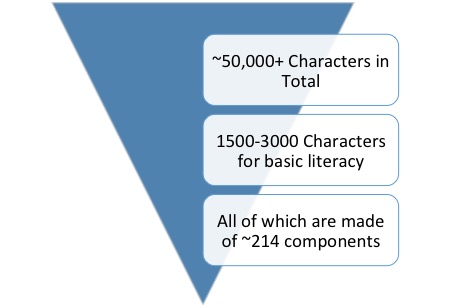
The fact that you can now recognise the 子 in the image above is a huge step forward.
You can already recognise one of the 214 pieces all characters are made up of.
Even better is the fact that of these 214 components it’s only the 50-100 most common you’ll be running into again and again.
This makes Chinese characters a lot less scary.
Once you get a handle on these basic components, you’ll quickly recognise all the smaller pieces and your eyes will stop glazing over!
This doesn’t mean you’ll necessarily know the meaning or how to pronounce the words yet (we’ll get onto this shortly) but suddenly Chinese doesn’t seem quite so alien any more.
Memorising The Components Of Chinese Characters
Memorising the pieces is not as important as simply realising that ALL of Chinese is constructed from these 214 pieces.
When I realised this, Chinese became a lot more manageable and I hope I’ve saved you some heartache by revealing this early in your learning process!
Here are some useful online resources for learning the components of Chinese characters:
- An extensive article about the 214 components of Chinese characters with a free printable PDF poster.
- Downloadable posters of all the components, characters and words.
- If you like flashcards, there’s a great Anki deck here and a Memrise course here.
- Wikipedia also has a sweet sortable list here.
TAKEAWAY: Every single Chinese character is composed of just 214 “pieces”. Only 50-100 of these are commonly used. Learn these pieces first to learn how to write in Chinese quickly.
Moving From Components To Chinese Characters

Once you’ve got a grasp of the basic building blocks of Chinese it’s time to start building some characters!
We used the character 好 (“good”) in the above example. 好 is a character composed of the components 女 (“woman”) and 子 (“child”).
Unlike the letters of the alphabet in English, these components have meaning.
(They also have pronunciation, but for the sake of simplicity we’ll leave that aside for now!)
- 女 means “woman” and 子 means “child”.
- When they are put together, 女 and 子 become 好 …and the meaning is “good”.
- Therefore “woman” + “child” = “good” in Chinese 🙂
When learning how to write in Chinese characters you can take advantage of the fact that components have their own meanings.
In this case, it is relatively easy to make a mnemonic (memory aid) that links the idea of a woman with her baby as “good”.
Because Chinese is so structured, these kind of mnemonics are an incredibly powerful tool for memorisation.
Some characters, including 好, can also be easily represented graphically. ShaoLan’s book Chineasy does a fantastic job of this.
Here’s the image of 好 for instance – you can see the mother and child.
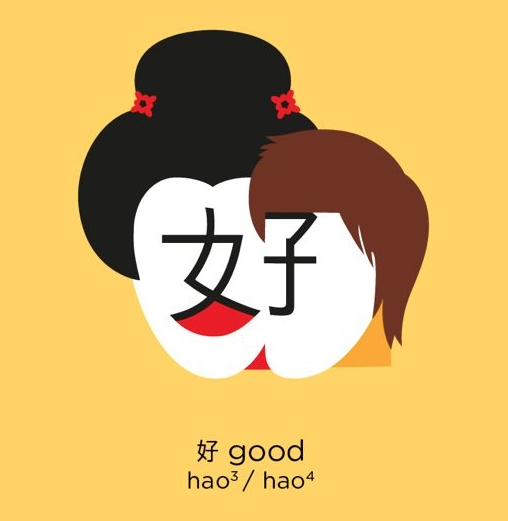
Visual graphics like these can really help in learning Chinese characters.
Unfortunately, only around 5% of the characters in Chinese are directly “visual” in this way. These characters tend to get the most attention because they look great when illustrated.
However, as you move beyond the concrete in the more abstract it becomes harder and harder to visually represent ideas.
Thankfully, the ancient Chinese had an ingenious solution, a solution that actually makes the language a lot more logical and simple than merely adding endless visual pictures.
Watch Me Write Chinese Characters
In the video below, which is part of a series on learning to write in Chinese, I talk about the process of actually writing out the characters. Not thousands of times like Chinese schoolchildren. But just as a way to reinforce my learning and attack learning Chinese characters from different angles.
My Chinese handwriting leaves a lot to be desired. But it’s more about a process of reinforcing my language learning via muscle memory than perfecting my handwriting.
You’ll also hear me discuss some related issues such as stroke order and typing in Chinese.
The Pronunciation Of Chinese Characters
The solution was the incredibly unsexy sounding… (wait for it…) “phono-semantic compound character”.
It’s an awful name, so I’m going to call them “sound-meaning characters” for now!
This concept is the key to unlocking 95% of the Chinese characters.
A sound-meaning character has a component that tells us two things:
- the meaning
- a clue to how the character is pronounced
So, in simple terms:
95% of Chinese characters have a clue to the meaning of the character AND its pronunciation.
Example:
到 means “to arrive”.
This character is made of two components. On the left is 至 and on the right is 刀.
These are two of the 214 components that make up all characters. 至 means “to arrive” and 刀 means “knife”.
Any idea which one gives us the meaning? Yup – it’s 至, “to arrive”! (That was an easy one 🙂 )
But how about the 刀? This is where it gets interesting.
到 is pronounced dào.
刀, “knife” is pronounced dāo.
The reason the 刀 is placed next to 至 in the character 到 is just to tell us how to pronounce the character! How cool is that?
Now, did you notice the little lines above the words: dào and dāo?
Those are the tone markers, and in this case they are both slightly different. These two characters have different tones so they are not exactly the same pronunciation.
However, the sound-meaning compound has got us 90% of the way to being able to pronounce the character, all because some awesome ancient Chinese scribe thought there should be a shortcut to help us remember the pronunciation!
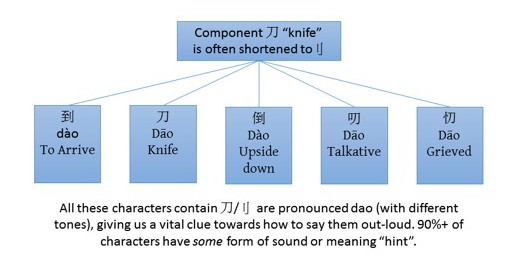
Let’s look at a few more examples of how 刀 is used in different words to give you an idea of the pronunciation.
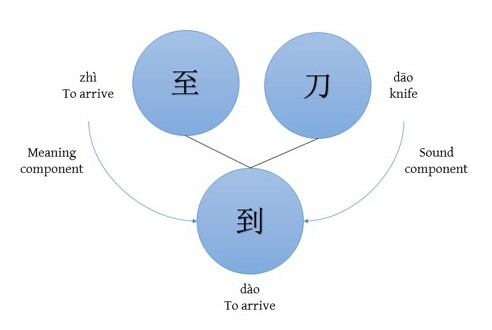
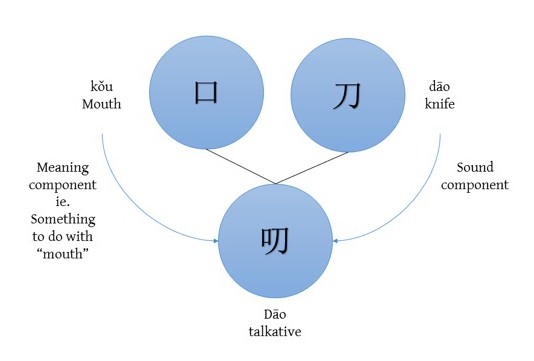
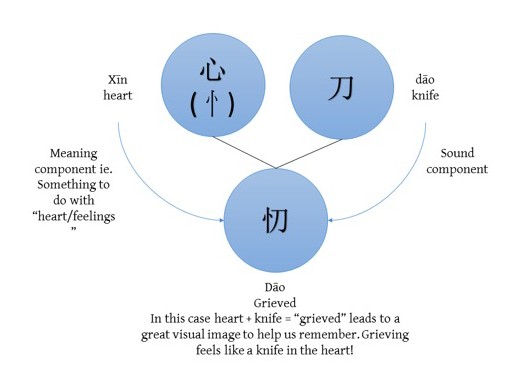
Even if sometimes:
- the sound-meaning character gives us the exact sound and meaning
- or it gets us in the ballpark
- or worse it is way off because the character has changed over the last 5,000 years!
Nevertheless, there’s a clue about the pronunciation in 95% of all Chinese characters, which is a huge help for learning how to speak Chinese.
TAKEAWAY: Look at the component parts as a way to unlock the meaning and pronunciations of 95% of Chinese characters. In terms of “hacking” the language, this is the key to learning how to write in Chinese quickly.
From Chinese Characters To Chinese Words
First we went from components to characters.
Next, we are going from characters to words.

Although there are a lot of one-character words in Chinese, they tend to either be classically-rooted words like “king” and “horse” or grammatical particles and pronouns.
The vast majority of Chinese words contain two characters.
The step from characters to words is where, dare I say it, Chinese script gets easy!
Come on, you didn’t think it would always be hard did you? 🙂
Unlike European languages Chinese’s difficulty is very front-loaded.
When you first learn to write Chinese, you’ll discover a foreign pronunciation system, a foreign tonal system and a very foreign writing system.
As an English speaker, you can normally have a good shot at pronouncing and reading words in other European languages, thanks to the shared alphabet.
Chinese, on the other hand, sucker-punches you on day one… but gets a little more gentle as you go along.
One you’ve realised these things:
- there aren’t that many components to deal with
- all characters are made up of these basic components
- words are actually characters bolted together
…then it’s a matter of just memorising a whole bunch of stuff!
That’s not to say there isn’t a lot of work involved, only to say that it’s not particularly difficult. Time-consuming, yes. Difficult, no.
This is quite different from European languages, which start off easy, but quickly escalate in difficulty as you encounter complicated grammar, tenses, case endings, technical vocabulary and so on.
Making words from Chinese characters you already know is easy and really fun. This is where you get to start snapping the lego blocks together and build that Pirate Island!
The Logic Of Chinese Writing
Here are some wonderful examples of the simplicity and logic of Chinese using the character 车 which roughly translates as “vehicle”.
- Water + Vehicle = Waterwheel = 水 +车
- Wind + Vehicle = Windmill = 风+车
- Electric + Vehicle = Tram/Trolley = 电+车
- Fire + Vehicle = Train = 火+车
- Gas + Vehicle = Car = 汽+车
- Horse + Vehicle = Horse and cart/Trap and Pony = 马+车
- Up + Vehicle = Get into/onto a vehicle =上+车
- Down + Vehicle = Get out/off a vehicle =下+车
- Vehicle + Warehouse = Garage = 车+库
- To Stop + Vehicle = to park = 停+车
Chinese is extremely logical and consistent.
This is a set of building blocks that has evolved over 5,000 years in a relatively linear progression. And you can’t exactly say the same about the English language!
Just think of the English words for the Chinese equivalences above:
Train, windmill, millwheel/waterwheel, tram/trolley, car/automobile, horse and cart/trap and pony.
Unlike Chinese where these concepts are all linked by 车 there’s very little consistency in our vehicle/wheel related vocabulary, and no way to link these sets of related concepts via the word itself.
English is a diverse and rich language, but that comes with its drawbacks – a case-by-case spelling system that drives learners mad.
Chinese, on the other hand, is precise and logical, once you get over the initial “alienness”.

Making The Complex Simple
This logical way of constructing vocabulary is not limited to everyday words like “car” and “train”. It extends throughout the language.
To take an extreme example let’s look at Jurassic Park.
The other day I watched Jurassic Park with my Chinese girlfriend. (OK, re-watched. It’s a classic!)
Part of the fun for me (annoyance for her) was asking her the Chinese for various dinosaur species.
Take a second to look through these examples. You’ll love the simplicity!
- T Rex 暴龙 = tyrant + dragon
- Tricerotops 三角恐龙 three + horn + dinosaur
- Diplodocus 梁龙 roof-beam + dragon
- Velociraptor 伶盗龙 clever + thief + dragon (or swift stealer dragon)
- Stegosaurus 剑龙 (double-edged) sword + dragon
- Dilophosaurus 双脊龙 double+spined+dragon
Don’t try to memorise these characters, just appreciate the underlying logic of how the complex concepts are constructed.
(Unless, of course, you are a palaeontologist…or as the Chinese would say a Ancient + Life + Animal + Scientist!).
I couldn’t spell half of these dinosaur names in English for this article. But once I knew how the construction of the Chinese word, typing in the right characters was simple.
Once you know a handful of characters, you can start to put together complete words, and knowing how to write in Chinese suddenly becomes a lot easier.
In a lot of cases you can take educated guesses at concepts and get them right by combining known characters into unknown words.
For more on this, check my series of Chinese character images that I publish on this page. They focus on Chinese words constructed from common characters, and help you understand more of the “building block” logic of Chinese.
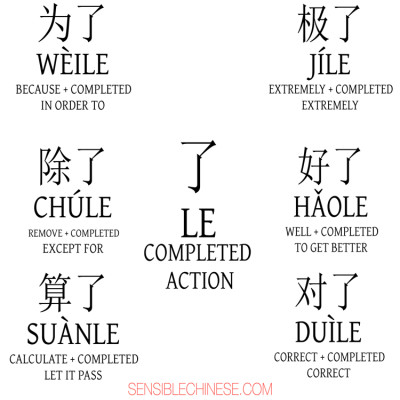
TAKEAWAY: Chinese words are constructed extremely logically from the underlying characters. This means that once you’ve learned a handful of characters vocabulary acquisition speeds up exponentially.
How To Learn Written Chinese Fast
Before diving into learning characters, make sure you have a decent grounding in Chinese pronunciation via the pinyin system.
The reason for this is that taking on pronunciation, tones and characters from day one is really tough.
Don’t get me wrong, you can do it. Especially if you’re highly motivated. But for most people there’s a better way.
Learn a bit of spoken Chinese first.
With some spoken language under your belt, and an understanding of pronunciation and tones, starting to learn how to write in Chinese will seem a whole lot easier.
When you’re ready, here’s how to use all the information from this article and deal with written Chinese in a sensible way.
I’ve got a systematic approach to written Chinese which you can find in detail on Sensible Chinese.
Right now, I’m going to get you started with the basics.
The Sensible Character System
The four stages for learning Chinese characters are:
- Input
- Processing
- Review
- Usage
Sounds technical huh? Don’t worry, it’s not really.
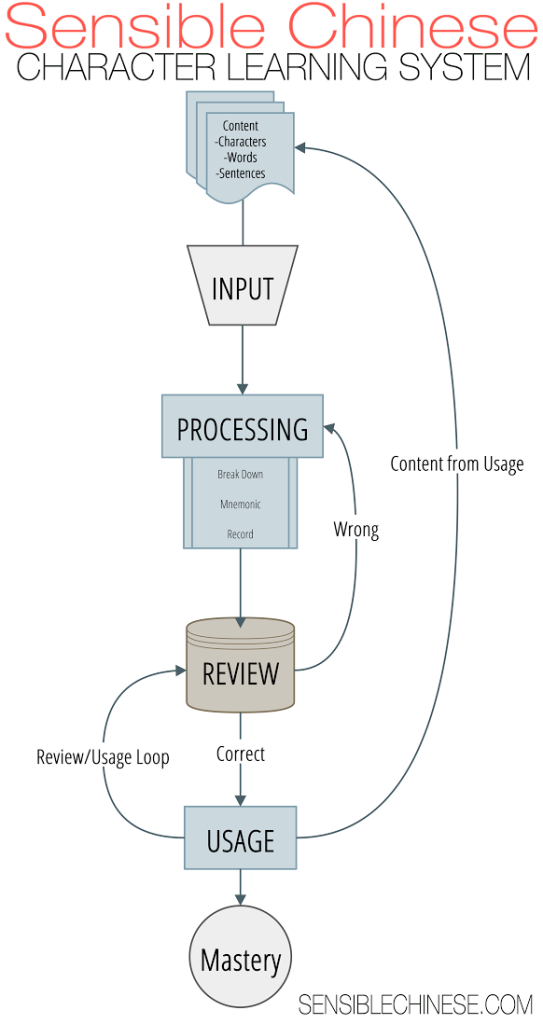
1. Input
This part of the process is about choosing what you put into your character learning system.
If you’re working on the wrong material then you’re wasting your efforts. Instead choose to learn Chinese characters that you are like to want to use in the future.
My list in order of priority contains:
- daily life: characters/words I’ve encountered through daily life
- textbooks: characters/words I’ve learnt from textbooks
- frequency lists: characters/words I’ve found in frequency lists of the most common characters and words
2. Processing
This is the “learning” part of the system.
You take a new word or character and break it down into its component parts. You can then use these components to create memory aids.
Hanzicraft.com or Pleco’s built-in character decomposition tool are fantastic for breaking down new characters. These will be helpful until you learn to recognise the character components by sight. These tools will also show you if there are sound-meaning component clues in the character.
Use the individual components of a character to build a “story” around the character. Personal, sexy and violent stories tend to stick in the mind best! 🙂 I also like to add colours into my stories to represent the tones (1st tone Green, 2nd tone Blue etc.)
3. Review
After the “input” and the “process”… it’s time to review it all!
The simplest review system is paper flashcards which you periodically use to refresh your memory.
A more efficient method can be found in software or apps that use a Spaced Repetition System, like Anki or Pleco.
An important point: Review is not learning.
It’s tempting to rely on software like Anki to drill in the vocabulary through brute-force repetition. But don’t skip the first two parts – processing the character and creating a mnemonic are key parts of the process.
4. Usage
It isn’t enough to just learn and review your words… you also need to put them into use!
Thankfully, technology has made this easier than ever. Finding a language exchange partner or a lesson with a cost-effective teacher is super simple nowadays, so there’s no excuse for not putting your new vocabulary into action!
The resources I personally use are:
- Spoken – iTalki
- Written – Lang-8
- Short form written – WeChat/HelloTalk
Importantly, whilst you are using your current vocabulary in these forms of communication, you’ll be picking up new content all the time, which you can add back into your system.
The four steps above are a cycle that you will continue to rotate through – all the corrections and new words you receive during usage should become material to add to the system.
To recap, the four steps of systematically learning Chinese characters are:
- Input
- Processing
- Review
- Usage
By building these steps into your regular study schedule you can steadily work through the thousands of Chinese characters and words you’ll need to achieve literacy.
This is a long-haul process! So having a basic system in place is very important for consistency.
You can find out a lot more about The Sensible Chinese Character Learning System and how to write in Chinese here.
Top Chinese Learning Links And Resources
- Chinese Language Learning Resource List – a curated list of tools and content available online and in print to help your Chinese learning, all categorised by usage type.
- Sensible Character Learning System – the full system outlined in a series of blog articles for those who want more detail and tips on how to refine their character learning.
- 111 Mandarin Chinese resources you wish you knew – Olly’s huge list of the best resources on the web for learning Chinese

I hope you enjoyed this epic guide to learning how to write in Chinese!
Please share this post with any friends who are learning Chinese, then leave us a comment below!
词典
Word dictionaryHelp
Tip: Press the small help links to get help about an item.
Input Chinese by handwring
You’ve got questions—we’ve got answers.
1. Why Handwriting Input?
Althogh it is hard to input Chinese by normal keyboard (you have to use Pinyin), it is very efficient to input Chinese using handwriting, especially on touch-screen devices. The reason is that Chinese characters have very special shape, which make it is very easy to tell which one it is from its topological structure. And in Chinese, each character is actually a word. This makes it even more efficient to use handwriting for input than other languages.
2. What if I don’t have a touch screen?
Even if you don’t have a touch screen, you can still use the handwriting for input Chinese by using the mouse.
3. Do I need to draw the character stroke by stroke?
No, you don’t. Since the handwriting input algorithmn use the topological shape instead of the stroke to recognize the character, you don’t need to draw the character stroke by stroke.
What’s this symbol?
The Language Level symbol shows a user’s proficiency in the languages they’re interested in. Setting your Language Level helps other users provide you with answers that aren’t too complex or too simple.
-
Has difficulty understanding even short answers in this language.
-
Can ask simple questions and can understand simple answers.
-
Can ask all types of general questions and can understand longer answers.
-
Can understand long, complex answers.
Sign up for premium, and you can play other user’s audio/video answers.
What are gifts?
Show your appreciation in a way that likes and stamps can’t.
By sending a gift to someone, they will be more likely to answer your questions again!

If you post a question after sending a gift to someone, your question will be displayed in a special section on that person’s feed.
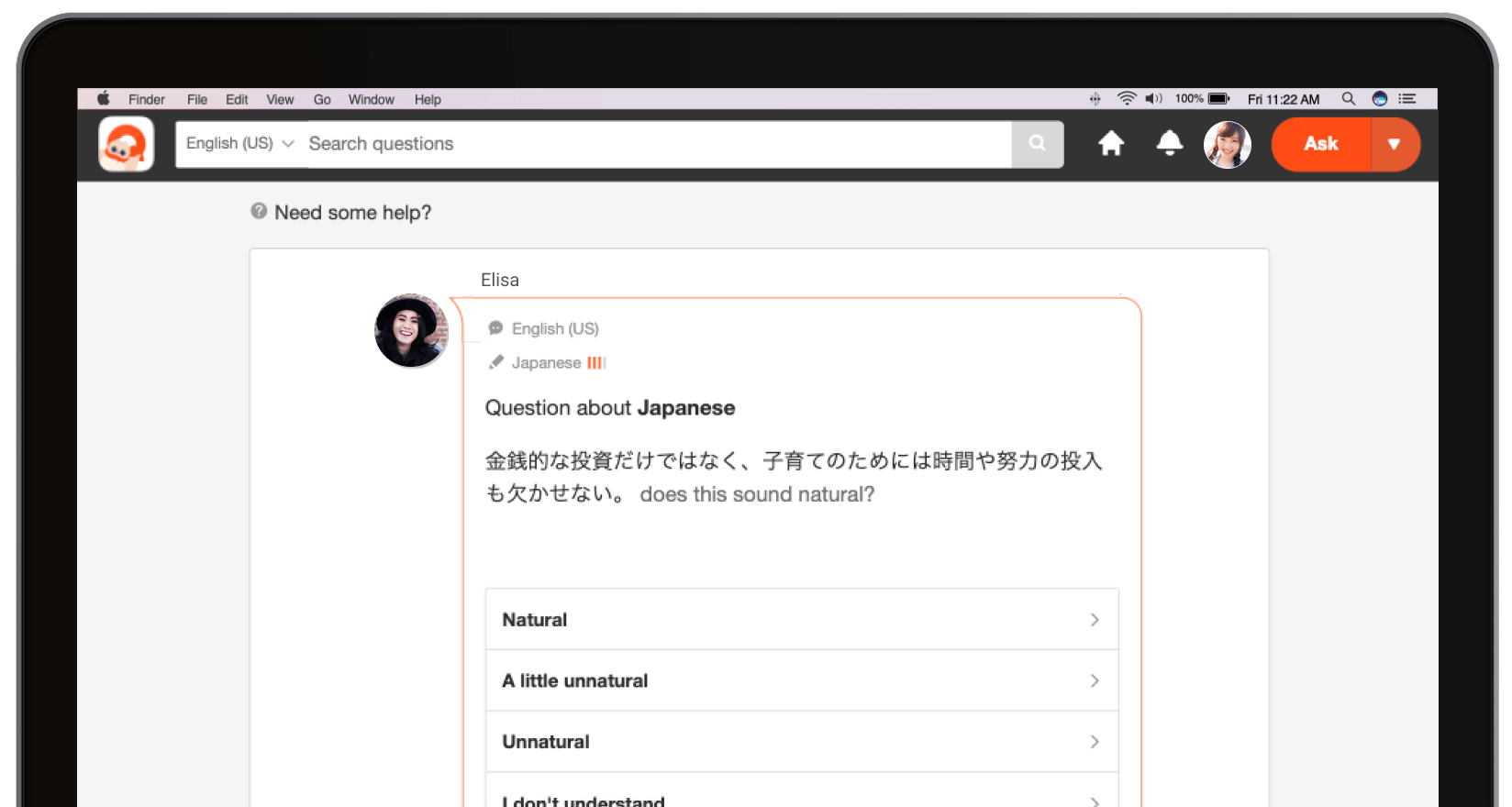
Tired of searching? HiNative can help you find that answer you’re looking for.
How to use our Chinese IME?
Our Chinese input method is an excellent resource for learning Chinese or typing in Chinese. We created this online Chinese input method (IME) as now there are very few Chinese input methods available as standalone websites. This is probably due to new technology and people using eg cellphones to type Chinese. This input method is particularly useful for people using computers where the settings are locked to disallow changes. Our IME is compatible with almost every web browser and doesn’t require additional software or applications.
If you’re not familiar with Chinese IME’s (input method editors), this Chinese typing guide will show you how to use our Chinese keyboard. If you are typing Chinese on a computer, you almost certainly will need to use an IME. This keyboard will require to be able to recognize the correct Chinese character for the context, especially as many have the same pinyin.
We have worked very hard to make our Chinese IME as easy to use. Enter the pinyin, then select the Chinese characters below. If the Chinese character does not appear in the first list, press the >> buttons to get to the next options. This Chinese input is designed for Hanyu pinyin and you can choose whether you type in simplified (简体)or traditional Chinese (繁体). You can change the size of the text or font size to make things clearer.
If you want to type words with sounds like lǚ or nǚ, you will need to type using a v so nv instead of nu. So lv you for 旅游 (lǚyóu).
We hope that our keyboard will allow you to type in Chinese at roughly the same rate as you normally type..There is also the option to change the size of the text that you type. Select the text size that is most comfortable for you by clicking on the icon with «汉». When you’ve finished typing your Chinese text, press the «copy» option at the bottom right and then paste it into your document.
This keyboard works in all modern browsers (Chrome, Internet Explorer, Safari, or any others).
Can you learn Chinese without learning how to type? It’s unlikely. If you want to be able to type Chinese characters fast, our Chinese keyboard is the best way to do it. Writing Chinese by hand is very slow and time consuming. Typing Chinese on a computer is much more convenient. There are other Chinese IME that don’t use pinyin and instead use something like Wubi. We are hopeful that in the future, we will also be able to offer a Wubi/ Wubi Hua/Jyutping IME.

By
Last updated:
February 11, 2023
Having a digital dictionary is essential for Chinese learners because of all the extra features it typically has:
- A character drawing option
- Pronunciation based on characters/pinyin (and vice versa)
- Stroke order
- And radical search and English-Chinese/Chinese-English translations, of course.
And these are just the basic functions you need.
To find this mythical perfect online Chinese dictionary, start with the five on our list!
Contents
- 文林‧免费版 (Wén lín‧miǎnfèi bǎn) — Wenlin Free Edition
- Pleco
- LINE Dictionary / Nciku
- 汉英词典 (Hàn yīng cídiǎn) — Hanping Chinese Dictionary Lite
- MDBG
Download:
This blog post is available as a convenient and portable PDF that you
can take anywhere.
Click here to get a copy. (Download)
文林‧免费版 (Wén lín‧miǎnfèi bǎn) — Wenlin Free Edition
Are you a student? A teacher? A near-fluent speaker? Wenlin is a go-to for every (aspiring) sinologist. You probably wouldn’t download Wenlin if you only need to translate something basic from time to time. You’ll want to use it during class or while translating extensive texts, rather than when walking around Beijing or ordering in a Chinese restaurant.
If that sounds like it suits you, then you can use this software to learn, translate and read Chinese text. There are five main products offered by the developers, and the free version has almost all you need!
There’s one amazing thing about Wenlin every user would appreciate—an extensive user’s guide. When you first download this software, it might not be that straightforward to use, so the guide is helpful. But once you get comfortable, Wenlin becomes your best friend.
Just be aware: Wenlin is an online software suitable for computer download with no smartphone option.
Here’s a sampling of what Wenlin can do:
- Text document translation. you can translate a whole document with Wenlin! If you want to read an online article or have a big translation to do, you can either copy and paste or open it in PDF in the program. As you go through the text with your cursor, translations automatically appear at the bottom. You’re able to see word translations, their breakdown (what each character means) and pinyin, too.
- Handwriting function. We all know the struggle. You need to translate a character, but don’t know how to pronounce it. The only way to find out what it means is by drawing it. Compared to physical dictionaries, where you usually have to look up characters by radicals, online dictionaries usually have a great advantage of allowing you to write the character. Wenlin counts your strokes, translates your character, provides pinyin, suggests words containing your character and even provides an example sentence.
- List of Chinese characters, pinyin and English words. This is a very physical dictionary-like function. English and pinyin words are listed alphabetically and Chinese characters are listed according to their frequency of usage.
And that’s just the tip of the iceberg. If you want a comprehensive, professional Chinese online dictionary, Wenlin is the right choice for you.
Pleco
Pleco is one of the most popular Chinese smartphone online dictionaries thanks to its user-friendly and straightforward format. It’s exactly what you need if you’re a beginner or just a visitor.
Pleco’s functionality is simple: It helps you translate, fast!
Want to know what the 鸡汤 tattooed on your friend’s shoulder means? (Yes, he’s not the first nor the last to get jītāng — chicken soup inked on his body.) Just draw it with one finger and Pleco will translate for you in seconds!
Need to talk to a native speaker, but struggling with pronunciation? Pleco will read it out loud for you!
Forgot how to write a character on a test? Don’t tell anyone, but Pleco will sort it out for you based on your English or pinyin entry!
Handwriting function, translation of characters, pinyin, English words and OCR (Chinese words look-up) are features that Pleco offers naturally. Plus, you can open a document and add flashcards.
Pleco will just do it all for you—quickly, easily and for free.
LINE Dictionary / Nciku
LINE Dictionary, formerly Nciku, is an online dictionary that’ll surely help you get through your first months of learning Chinese.
LINE Dictionary is easy to navigate—there are only three main sections: Dictionary, Translator and Today’s Expressions. So what makes this Chinese online dictionary so great?
Examples, examples, examples.
Every beginner language learner needs to learn how to use a word, what to pair a character with and different expressions. LINE has your back with tons of usage examples. Each word or expression comes with examples of it in use, and some even have full dialogues so you can see the words in action. Looking up “how are you,” for instance, brings up a staggering 131,000+ examples!
In each example, you can click on any Chinese or English word to see its meaning(s). And, best of all, every bit of this is recorded by actual Chinese speakers!
Like the previous dictionaries in our list, LINE has handwriting recognition, pronunciations and translations (characters, English words, pinyin). On top of that, though, LINE will help you speak by providing you with tons of context.
Finally, at the bottom of each conversation, you can find related words. By clicking on them, more examples and sentences become available so you can keep that learning going.
汉英词典 (Hàn yīng cídiǎn) — Hanping Chinese Dictionary Lite
Very similar to Pleco, Hanping works with smartphones and has all the functions we need from a Chinese dictionary. Apart from a Mandarin Chinese free version, there are Cantonese and paid versions, too.
Hanping is a top-notch HSK helper. Being easily accessible, free and smartphone-friendly makes it very popular among Chinese learners.
Is typing taking too long? Can’t copy and paste? Want to just quickly lookup a character? Hanping dictionary has a camera scan function! The dictionary allows you to scan Chinese text into the app and translates it, even with vertical text.
Another amazing feature that helps with real-life conversations, but also simply makes the learning process easier, is a voice recorder. Thanks to the app microphone, you can speak either English or Chinese and the dictionary recognizes each word and provides translations in a second.
There’s a little bit of a drawback there, though—Hanping only translates words, so if you need a whole sentence translator, this one won’t be the one.
Besides the character drawing function, Hanping also offers a character lookup function based on the number of strokes. This might be useful while learning, but if you need a quick translation, go for the handwriting option.
One thing that makes Hanping special is its idioms dictionary. Finally, in addition to HSK and YCT exams dictionaries, a conversational one is also included.
MDBG
If you’re not into fluffy pretty dictionaries with all the functions in the world, then MDBG might be for you.
Although the design of the website and the dictionary is quite simple, it does its job—and offers extra features, as well.
MDBG is great if you just need a translation from time to time, but don’t want anything to take up space on your phone. It has all the essentials: translations for both English and pinyin lookups, as well as a Chinese character search.
You just can’t have an online Chinese dictionary without a handwriting function and you bet MDBG is no exception!
Don’t let MDBG’s simplicity fool you: It also has a special feature! The dictionary lets you test yourself with a quiz. Based on HSK vocabulary, you can either take a Chinese Character Quiz, learn new Chinese characters with flashcards or you can subscribe to their web feed and learn 10 new words a day.
Whether you’re a student, teacher or visitor, it’s a good idea to have a Chinese online dictionary on hand.
No matter what you’re looking for, these five dictionaries have you covered.
祝你好运 (Zhù nǐ hǎo yùn) — Good luck!
Download:
This blog post is available as a convenient and portable PDF that you
can take anywhere.
Click here to get a copy. (Download)
Chinese Characters And Pinyin Worksheet Creator is a is a web-tool which you can create your own chinese character and pinyin worksheet to practiced writing, it support create Chinese characters and pinyin stroke order worksheet. Any questin please mail to 8@an2.net.
Please enter your Chinese character below (characters limit 200):
Character type: Words Stroke order Article
Worksheet type:
No Worksheet
Worksheet Color: Green Bkack Red
Character Color: Green Black Red
Background colour: Very dark Dark Less dark Less light Standard Very light Hollow character
Fill page tail: Yes No
Typeface: Regular Script(support stroke order) Pang Zhonghua Typeface Tian Yingzhang Typeface Custom
Page header:
Get Pinyin
Notice
Please read the following words:
Make sure the right font is installed;
Please check the box «print background image and color» when you print the worksheet;
step 1:enter your Chinese character below, terms separate by «,», click the «Get Pinyin» button;
step 2:confirm the pinyin and update the mistake of polyphone;
step 3:click the «Generate» button;
step 4:print to paper;
Please check the box «print background image and color» when you print the worksheet.
Example 1
Example 2
Example 3
There are two directions you mentioned:
- transliteration or romanisation using Wade-Giles (
Taofor道) or Pinyin (Daofor道) to write/spell/pronounce chinese characters/words (see Taoism VS Daoism). This facilitates the usage of Chinese words in English language (e.g. Beijing). - loan words or using English words in Chinese language
You are asking for the latter.
How to choose characters?
For the selection of matching chinese characters there is always the trade-off between phonetic (sound) as well as semantic (meaning) similarity.
Some are just resembling phonetic:
For example 打的 (dadi) means (to go by) taxi. It’s colloquial although there are «original» chinese idioms for that, e.g. 出租车 (chuzuche) meaning taxi (or rental-car in Taiwanese).
Difficult to reflect both, sound and meaning:
Especially foreign businesses are smartly applying creativity to give there brands recognizable chinese names (easy to associate and remember).
That effort leads for example to IKEA translated to 宜家 (yijia) literally proper-home, or Cola to 可乐 (kele) literally amusing/entertaining.
Localised Foreign Brand Names
Since you are asking especially for the «translation» of brand names, there are further aspects for selecting the right characters/words:
- cultural fit
- socioeconomic and psychological associations
- historical and traditional reflections
Above factors are essential for designing brands, not only for translating their names.
The difficulty in selecting a suitable chinese brand name may even include visual (stylish) aspects: aesthetic and beauty of the characters, since they should appeal visually to the target audience:
The translation from English brand to Chinese brand involves issues of “translating a name from a letters -and- phonemes-based phonographic language (i.e. English) to a visual-character-based logographic language (i.e. Chinese)” (Schmitt & Zhang, 2012, p.656).
Refer to examples where the name was selected to incorporate such aspects, although neither matching phonetically nor semantically:
- Poison (a luxury fragrance) was retranslated to
百爱神(Bai Ai Shen), which means everyone will love it. So that people would like to purchase it, rather than they would if it has a negative connotation like its original name and meaning.
Further Reading
Branding in China is covered by many Studies and Research Papers, published at Universities by sinologists and economists alike:
- Shi, H. (2017). Translation Strategies from Target Culture Perspective: An Analysis of English and Chinese Brands Names. International Journal of English Language & Translation Studies. 5 (1), 15-22.
- Berende, B. (2012) : What’s in a Name? A study on the success factors of brand naming in China. Master Thesis, Jönköping International Business School
500+ Chinese Vocabulary 📚Your Complete List
Welcome to the ultimate Chinese Vocabulary blog!
If there’s one thing we know all too well at LTL Mandarin School, it’s a good old fashioned Chinese vocabulary blog.
We’ve written dozens, fact-checked by our incredible Mandarin teachers.
Plus, have made thousands of flashcards to help our readers memories the Chinese vocabulary they’re learning.
You can find all our flashcards on our Pinterest and Instagram.
We’ve created this to be a helpful directory to access to top 10 words in each of our Chinese vocabulary blogs AND give you access to all our Chinese vocabulary videos in one convenient location.
Put your skills to the test with one of HSK Vocabulary tests and find our what level you’re at today, for FREE!
BONUS FREEBIE – Take the ULTIMATE Chinese Vocabulary Quiz ⬇️⬇️⬇️
Academic Vocabulary
| Chinese Vocabulary | Characters | Pinyin |
|---|---|---|
| School | 学校 | xuéxiào |
| Classroom | 教室 | jiàoshì |
| Student | 学生 | xuéshēng |
| Teacher | 老师 | lǎoshī |
| Textbook | 课本 | kèběn |
| Homework | 作业 | zuòyè |
| Quiz | 测验 | cèyàn |
| Exam | 考试 | kǎoshì |
| History | 历史学 | lìshǐ xué |
| Geography | 地理学 | dì lǐ xué |
Play
See our full list of academic vocabulary.
Chinese Vocabulary: Alcohol
| Vocabulary | Characters | Pinyin |
|---|---|---|
| Beer | 啤酒 | píjiǔ |
| Baijiu | 白酒 | bái jiǔ |
| Wine | 葡萄酒 | pú táo jiǔ |
| Red Wine | 红酒 | hóngjiǔ |
| White Wine | 白葡萄酒 | bái pútáojiǔ |
| Sparkling Wine | 气泡酒 | qìpào jiǔ |
| Champagne | 香槟酒 | xiāng bīn jiǔ |
| Vodka | 伏特加 | fú tè jiā |
| Whiskey | 威士忌 | wēi shì jì |
| Gin | 劲酒 | jìn jiǔ |
Play
Discover more alcohol in Chinese.
Allergies in Chinese
| Chinese Vocabulary | Characters | Pinyin |
|---|---|---|
| Allergic | 过敏 | guò mǐn |
| Bless You | 一百岁 | yī bǎi suì |
| Hay Fever | 花粉症 | huāfěn zhèng |
| Pollen | 花粉 | huā fěn |
| Spring | 春天 | chūn tiān |
Learn more about allergies in Chinese
Animals in Chinese
| Vocabulary | Characters | Pinyin |
|---|---|---|
| Animal | 动物 | dòng wù |
| Dog | 狗 | gǒu |
| Dragon | 龙 | lóng |
| Dolphin | 海豚 | hǎi tún |
| Snake | 蛇 | shé |
| Cow | 牛 | niú |
| Rat | 鼠 | shǔ |
| Tiger | 虎 | hǔ |
| Rabbit | 兔子 | tù zǐ |
| Horse | 马 | mǎ |
Play
Find all the animals in Chinese
Chinese Vocabulary: Body Parts
| Chinese Vocabulary | Characters | Pinyin |
|---|---|---|
| Body | 身体 | shēn tǐ |
| Head | 头 | tóu |
| Face | 脸 | liǎn |
| Mouth | 嘴 | zuǐ |
| Chest | 胸 | xiōng |
| Back | 背 | bèi |
| Arm | 胳膊 | gē bo |
| Hand | 手 | shǒu |
| Leg | 腿 | tuǐ |
| Feet | 脚底 | jiǎodǐ |
Discover all the body parts in Chinese.
Chess in Chinese
| Vocabulary | Characters | Pinyin |
|---|---|---|
| Chess (International) | 国际象棋 | guó jì xiàng qí |
| Chinese Chess | 象棋 | xiàngqí |
| Chess Piece | 棋子 | qízǐ |
| Chess Player | 棋手 | qí shǒu |
| Chess Board | 棋盘 | qí pán |
| White Piece | 白棋 | bái qí |
| Black Piece | 黑棋 | hēi qí |
| Pawn | 兵, 卒 | bīng, zú |
| Queen | 后 | hòu |
| King | 王 | wáng |
Learn more about Chess in Chinese.
Chinese Vocabulary: Clothes
| Chinese Vocabulary | Characters | Pinyin |
|---|---|---|
| Trousers | 裤子 | kù zi |
| Jeans | 牛仔裤 | niú zǎi kù |
| Shorts | 短裤 | duǎn kù |
| Dress | 连衣裙 | liányīqún |
| Skirt | 裙子 | qún zi |
| T-shirt | T恤 | T xù |
| Jumper | 毛衣 | máo yī |
| Suit | 西装 | xī zhuāng |
| Shoe | 鞋 | xié |
| Socks | 袜子 | wàzi |
Discover all the clothes in Chinese.
Coffee in Chinese
| Vocabulary | Characters | Pinyin |
|---|---|---|
| Coffee | 咖啡 | kāfēi |
| Latte | 拿铁 | nátiě |
| Cappuccino | 卡布基诺 | kǎbùjīnuò |
| Americano | 美式咖啡 | měishì Kāfēi |
| Espresso | 浓缩咖啡 | nóngsuō kāfēi |
| Hot | 热的 | rè de |
| Cold | 冰的 | bīng de |
| Milk | 牛奶 | niúnǎi |
| Sugar | 糖 | táng |
| Caramel | 焦糖 | jiāo táng |
Play
Find more ways to order coffee in Chinese.
Colours in Chinese
| Chinese Vocabulary | Characters | Pinyin |
|---|---|---|
| Black | 黑色 | hēi sè |
| White | 白色 | bái sè |
| Red | 红色 | hóng sè |
| Pink | 粉色 | fěn sè |
| Green | 绿色 | lǜ sè |
| Yellow | 黄色 | huáng sè |
| Blue | 蓝色 | lán sè |
| Purple | 紫色 | zǐ sè |
| Gray | 灰色 | huī sè |
| Gold | 金色 | jīn sè |
Play
Learn all the colours in Chinese.
Chinese Vocabulary: Directions
| Vocabulary | Characters | Pinyin |
|---|---|---|
| Left | 左边 | zuǒ biān |
| Right | 右边 | yòu biān |
| Go straight | 直走 | zhí zǒu |
| Go backwards | 向后走 | xiàng hòu zǒu |
| Up | 向上 | xiàng shàng |
| Down | 向下 | xiàng xià |
| Over | 通过 | guò |
| Through | 通过 | tōng guò |
| Stop | 停 | tíng |
| North | 北 | běi |
Play
See our full list of directions in Chinese.
Dog Breeds in Chinese
| Chinese Vocabulary | Characters | Pinyin |
|---|---|---|
| Dog | 狗 | gǒu |
| Paw | 爪 zhuǎ | zhuǎ |
| Snout | 口鼻部 | kǒu bí bù |
| Tail | 尾巴 | wěi ba |
| To Bite | 咬人 | yǎo rén |
| To Sniff | 闻 | wén |
| To Bark | 吠 | fèi |
| Bulldog | 牛头 | niú tóu |
| Poodle | 贵宾 | guì bīn |
| Sheepdog | 牧羊 | mù yáng |
Discover more dog breeds in Chinese.
Easter in Chinese
| Vocabulary | Characters | Pinyin |
|---|---|---|
| Easter | 复活节 | fùhuó jié |
| Happy Easter | 复活节快乐 | fùhuó jié kuàilè |
| Easter Bunny | 复活节兔子 | fùhuó jié tùzǐ |
| Easter Egg | 彩蛋 | cǎidàn |
| Easter Egg Hunt | 寻找彩蛋 | xúnzhǎo cǎidàn |
| Hot Cross Buns | 十字餐包 | shízì cān bāo |
| chocolate | 巧克力 | qiǎokèlì |
| decorations | 装饰 | zhuāngshì |
| lambs | 羊羔 | yánggāo |
| chicks | 小鸡 | xiǎo jī |
Learn more about Easter in Chinese.
Eggs in Chinese
| Vocabulary | Characters | Pinyin |
|---|---|---|
| Chicken | 鸡蛋 | jī dàn |
| Duck | 鸭子蛋 | yā zi dàn |
| Emu | 鸸鹋蛋 | ér miáo dàn |
| Baked Egg | 烘蛋 | hōng dàn |
| Boiled Egg | 水煮蛋 | shuǐ zhǔ dàn |
| Fried Egg | 煎鸡蛋 | jiān jīdàn |
| Omelette | 煎蛋卷 | jiān dàn juǎn |
| Poached egg | 荷包蛋 | hébāodàn |
| Scrambled Egg | 炒蛋 | chǎo dàn |
| Yolk | 蛋黄 | dàn huáng |
Get all the eggs in Chinese.
Chinese Vocabulary: Elections
| Vocabulary | Characters | Pinyin |
|---|---|---|
| Democratic Party | 民主党 | mínzhǔdǎng |
| Republican Party | 共和党 | gònghédǎng |
| Libertarian Party | 自由意志党 | zìyóu yìzhì dǎng |
| Green Party | 绿党 | lǜdǎng |
| Constitution Party | 宪法党 | xiànfǎ dǎng |
| Politics | 政治 | zhèngzhì |
| Democracy | 民主 | mínzhǔ |
| Presidential Debate | 总统辩论 | zǒngtǒng biànlùn |
| Voting | 投票 | tóupiào |
| Nominate | 提名 | tímíng |
Get more on elections in Chinese.
Encouragement in Chinese
| Vocabulary | Characters | Pinyin |
|---|---|---|
| Congratulations to you! | 恭喜你 | gōng xǐ nǐ |
| I’m happy for you! | 我都替你高兴 | wǒ dōu tì nǐ gāo xìng |
| I am so happy for you! | 我真为你高兴 | wǒ zhēn wèi nǐ gāoxìng |
| Well done! | 干得好 | gàn dé hǎo |
| Excellent! | 太棒了 | tài bàng le |
| You are awesome! | 你真棒 | nǐ zhēn bàng |
| Amazing! | 了不起 | liǎo bù qǐ! |
| You are so great! | 你太厉害了 | tài lì hai le |
| Don’t give up! | 不要放弃 | bù yào fàng qì |
| You can do it! | 你可以的 | nǐ kěyǐ de |
Get all the encouragement in Chinese.
Feelings in Chinese
| Vocabulary | Characters | Pinyin |
|---|---|---|
| Excited | 兴奋 | xīngfèn |
| Grateful | 感激的 | gǎnjīde |
| Brave | 勇敢 | yǒnggǎn |
| Carefree | 无忧无虑 | wú yōu wú lǜ |
| Angry | 生气 | shēngqì |
| Annoyed | 恼火 | nǎo huǒ |
| Anxious | 焦虑 | jiāo lǜ |
| Bored | 厌烦 | yàn fán |
| Competitive | 有竞争力 | yǒu jìngzhēng lì |
| Hungry | 饿 | è |
Learn all the feelings in Chinese.
Chinese Vocabulary: Fish
| Vocabulary | Charachters | Pinyin |
|---|---|---|
| Bream | 鳊鱼 | biān yú |
| Catfish | 鲶鱼 | nián yú |
| Crab | 螃蟹 | páng xiè |
| Flounder | 比目鱼 | bǐ mù yú |
| Jellyfish | 海蜇 | hǎi zhé |
| Lobster | 小龙虾 | xiǎo lóng xiā |
| Octopus | 章鱼 | zhāng yú |
| Piranha | 食人鱼 | shí rén yú |
| Salmon | 鲑鱼 | guī yú |
| Tuna | 金枪鱼 | jīn qiāng yú |
Get more Fish in Chinese
Chinese Vocabulary: Fruit
| Chinese Vocabulary | Characters | Pinyin |
|---|---|---|
| Apple | 苹果 | píng guǒ |
| Avocado | 牛油果 | niú yóu guǒ |
| Banana | 香蕉 | xiāng jiāo |
| Blueberry | 蓝莓 | lán méi |
| Coconut | 椰子 | yē zi |
| Grape | 葡萄 | pú táo |
| Grapefruit | 柚子 | yòu zi |
| Lemon | 柠檬 | níng méng |
| Lime | 酸橙 | suān chéng |
| Mango | 芒果 | máng guǒ |
Play
Get more fruit in Chinese.
Furniture in Chinese
| Vocabulary | Characters | Pinyin |
|---|---|---|
| Table | 桌子 | zhuō zi |
| Chair | 椅子 | yǐ zi |
| Bed | 床 | chuáng |
| Couch | 沙发 | shā fā |
| Mirror | 镜子 | jìng zi |
| Carpet | 地毯 | dìtǎn |
| Fireplace | 壁炉 | bì lú |
| Wallpaper | 墙纸 | qiáng zhǐ |
| Blinds | 百叶窗 | bǎi yè chuāng |
| Table lamp | 台灯 | tái dēng |
See our full list of furniture in Chinese.
Hello in Chinese
| Vocabulary | Characters | Pinyin |
|---|---|---|
| Hello (Standard) | 你好 | nǐ hǎo |
| Hello (Polite) | 您好 | nín hǎo |
| How are you? | 你好吗 | nǐ hǎo ma |
| How are you? (Polite) | 您好吗 | nín hǎo ma |
| what’s up? | 你怎么样 | nǐ zěnmeyàng |
| nice to meet you | 幸会 | xìnghuì |
| (Very formal greeting) | 久仰 | jiǔyǎng |
| Morning! | 早 | zǎo |
| Have you eaten? | 你吃了吗 | nǐ chī le ma |
| Hello (answering phone) | 喂 | wèi |
Play
Find more ways to say hello in Chinese.
Chinese Vocabulary: The House
| Vocabulary | Characters | Pinyin |
|---|---|---|
| House | 家 | jiā |
| Basement | 地下室 | dìxià shì |
| Bathroom | 洗手间 | xǐshou jiān |
| Dining Room | 餐厅 | cāntīng |
| Bedroom | 卧室 | wòshì |
| Kitchen | 厨房 | chúfáng |
| Office | 办公室 | bàngōngshì |
| Downstairs | 楼下 | lóuxià |
| Upstairs | 楼上 | lóushang |
| Toilet | 卫生间 | wèishēng jiān |
Get all the vocabulary for a house in Chinese.
Instruments in Chinese
| Chinese Vocabulary | Characters | Pinyin |
|---|---|---|
| Guitar | 吉他 | jítā |
| Cello | 大提琴 | dàtíqín |
| Violin | 小提琴 | xiǎotíqín |
| Harp | 竖琴 | shùqín |
| Piano | 钢琴 | gāngqín |
| Xylophone | 木琴 | mùqín |
| Drums | 鼓 | gǔ |
| Trumpet | 喇叭 | lǎbā |
| Trombone | 长号 | cháng hào |
| Flute | 长笛 | chángdí |
Play
Discover all the instruments in Chinese.
Jewellery in Chinese
| Vocabulary | Characters | Pinyin |
|---|---|---|
| Ring | 戒指 | jièzhi |
| Necklace | 项链 | xiàngliàn |
| Bracelet | 手链 | shǒuliàn |
| Earrings | 耳环 | ěrhuán |
| Nose ring | 鼻环 | bíhuán |
| Gold | 黄金 | huángjīn |
| Silver | 银 | yín |
| Diamond | 钻石 | zuànshí |
| Tiffany & Co | 蒂芙尼 | dìfúní |
| Pandora | 潘多拉 | pānduōlā |
Find more jewellery in Chinese.
Chinese Vocabulary: Makeup
| Vocabulary | Characters | Pinyin |
|---|---|---|
| Face | 脸 | liǎn |
| Forehead | 额头 | é’tóu |
| Eyebrows | 眉毛 | méimáo |
| Foundation | 粉底 | fěndǐ |
| Bronzing powder | 古铜粉 | gǔ tóng fěn |
| Highlighter | 高光 | gāoguāng |
| Contour | 修容 | xiū róng |
| Concealer | 遮瑕膏 | zhēxiá gāo |
| Blush | 腮红 | sāihóng |
| Eye shadow | 眼影 | yǎnyǐng |
Learn all the makeup in Chinese.
Maths in Chinese
| Vocabulary | Characters | Pinyin |
|---|---|---|
| Number | 数字 | shù zì |
| Odd | 奇数的 | jī shù de |
| Even | 偶数的 | ǒu shù de |
| Plus/Add | 加法 | jiā fǎ |
| One Half (1/2) | 二分之一 | èrfēn zhīyī |
| One Third (1/3) | 三分之一 | sānfēn zhīyī |
| One Quarter (1/4) | 四分之一 | sìfēn zhīyī |
| Arithmetic | 算术 | suàn shù |
| Algebra | 代数 | dài shù |
| Calculus | 微积分 | wēi jī fēn |
Play
Get more math in Chinese.
Chinese Vocabulary: Measure Words
| Chinese Vocabulary | Characters | Pinyin |
|---|---|---|
| generic | 个 | gè |
| flat things (paper) | 张 | zhāng |
| books | 本 | běn |
| glasses or cups | 杯 | bēi |
| bottles | 瓶 | píng |
| clothing, presents or problems | 件 | jiàn |
| families or business | 家 | jiā |
| animals | 只 | zhī |
| vehicles with wheels | 辆 | liàng |
| A pair of (something) | 双 | shuāng |
See our full list of measure words.
Measurements in Chinese
| Vocabulary | Characters | Pinyin |
|---|---|---|
| gram | 克 | kè |
| milligram | 毫克 | háo kè |
| kilogram | 公斤 | gōng jīn |
| ton | 吨 | dūn |
| length | 长 | cháng |
| metre | 米 | mǐ |
| centimetre | 厘米 | lí mǐ |
| kilometre | 公里 | gōng lǐ |
| litre | 升 | shēng |
| hectare | 公顷 | gōng qǐng |
Discover more measurements in Chinese.
Mobile Phone (settings) in Chinese
| Vocabulary | Characters | Pinyin |
|---|---|---|
| SIM card | SIM 卡 | sim kǎ |
| Battery | 电池 | diàn chí |
| Button | 按钮 | àn niǔ |
| Charger | 充电器 | chōng diàn qì |
| Contacts | 电话簿 | diàn huà bù |
| WiFi | 无线 | wú xiàn |
| Notification | 通知 | tōng zhī |
| 邮件 | yóu jiàn | |
| 微信 | wēi xìn | |
| Camera | 相机 | xiàng jī |
Learn more about your phone in Chinese.
Money in Chinese
| Vocabulary | Characters | Pinyin |
|---|---|---|
| money | 钱 | qián |
| coin | 硬币 | yìngbì |
| debt | 债务 | zhài wù |
| bank | 银行 | yín háng |
| credit card | 信用卡 | xìn yòng kǎ |
| price | 价钱 | jià qian |
| to pay | 付 | fù |
| give change | 零钱 | líng qián |
| ATM | 自动取款机 | zì dòng qǔ kuǎn jī |
| exchange rate | 汇率 | huì lǜ |
Play
Get all the money in Chinese.
Chinese Vocabulary: Numbers
| Vocabulary | Characters | Pinyin |
|---|---|---|
| 0 | 零 | líng |
| 1 | 一 | yī |
| 2 | 二 | èr |
| 3 | 三 | sān |
| 10 | 十 | shí |
| 99 | 九十九 | jiǔ shí jiǔ |
| 100 | 一百 | yì bǎi |
| Year | 年 | nián |
| month | 月 | yuè |
| Date | 日 | rì |
Discover all the numbers in Chinese.
Occupations in Chinese
| Vocabulary | Characters | Pinyin |
|---|---|---|
| Job | 工作 | gōngzuò |
| Accountant | 会计 | kuài jì |
| Designer | 设计师 | shè jì shī |
| Lawyer | 律师 | lǜ shī |
| Beautician | 美容师 | měi róng shī |
| Doctor | 医生 | yī shēng |
| Hairdresser | 理发师 | lǐ fà shī |
| Artist | 艺术家 | yì shù jiā |
| Farmer | 农民 | nóngmín |
| Teacher | 老师 | lǎo shī |
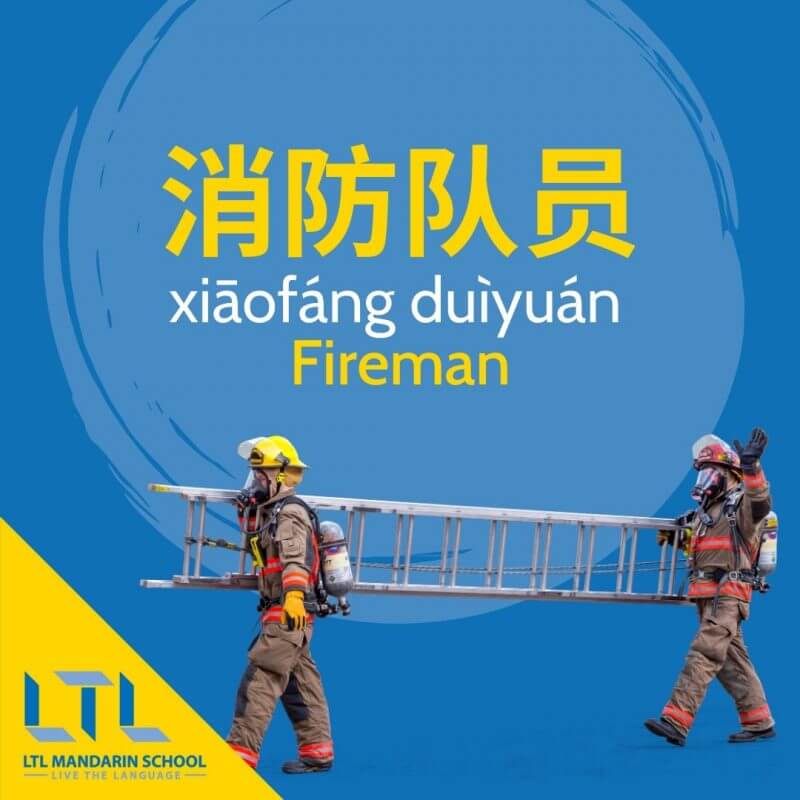

Find more occupations in Chinese.
Olympics in Chinese
| Vocabulary | Characters | Pinyin |
|---|---|---|
| Olympic Games | 奥运会 | ào yùn huì |
| Olympic Torch | 奥运会的圣火 | àoyùnhuì de shènghuǒ |
| The Olympic Flag | 奥运会会旗 | àoyùnhuìhuìqí |
| Opening Ceremony | 奥运会开幕式 | àoyùnhuì kāimù shì |
| Swimming | 游泳 | yóuyǒng |
| Athletics | 田径 | tiánjìng |
| Cycling | 自行车 | zìxíngchē |
| Gold medal | 金牌 | jīnpái |
| Athlete | 运动员 | yùndòngyuán |
| Paralympic Games | 残奥会 | cán ào huì |


Learn all the vocabulary for the Olympics in Chinese.
Chinese Vocabulary: Opposites
| Vocabulary | Characters | Pinyin |
|---|---|---|
| Rich | 富有 | fù yǒu |
| Poor | 贫穷 | pín qióng |
| Sick | 生病 | shēng bìng |
| Healthy | 健康 | jiàn kāng |
| Big | 大 | dà |
| Small | 小 | xiǎo |
| Fast | 快 | kuài |
| Slow | 慢 | màn |
| Happy | 快乐 | kuài lè |
| Sad | 伤心 | shāngxīn |
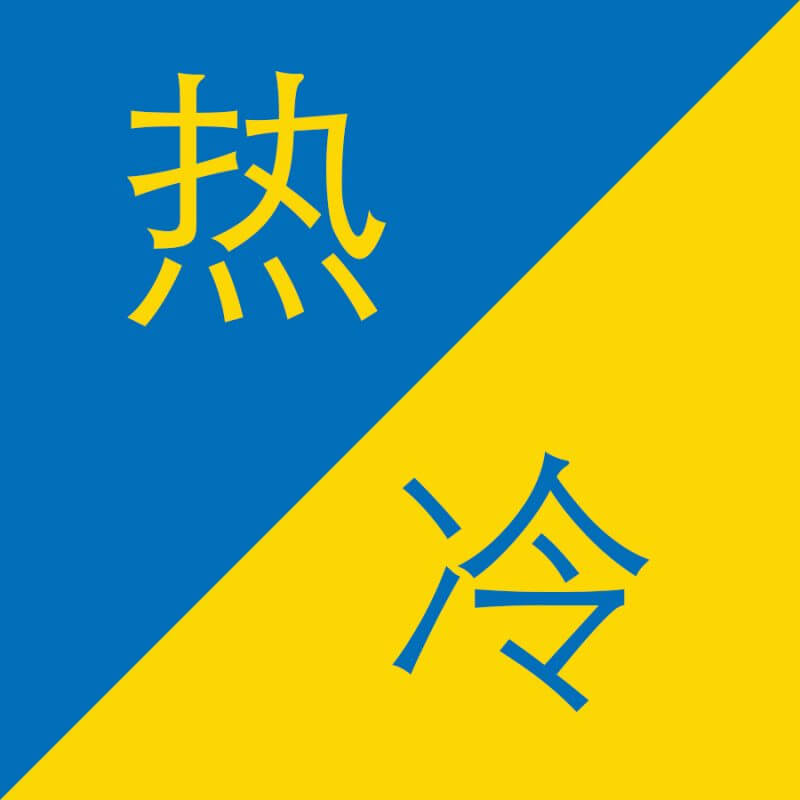
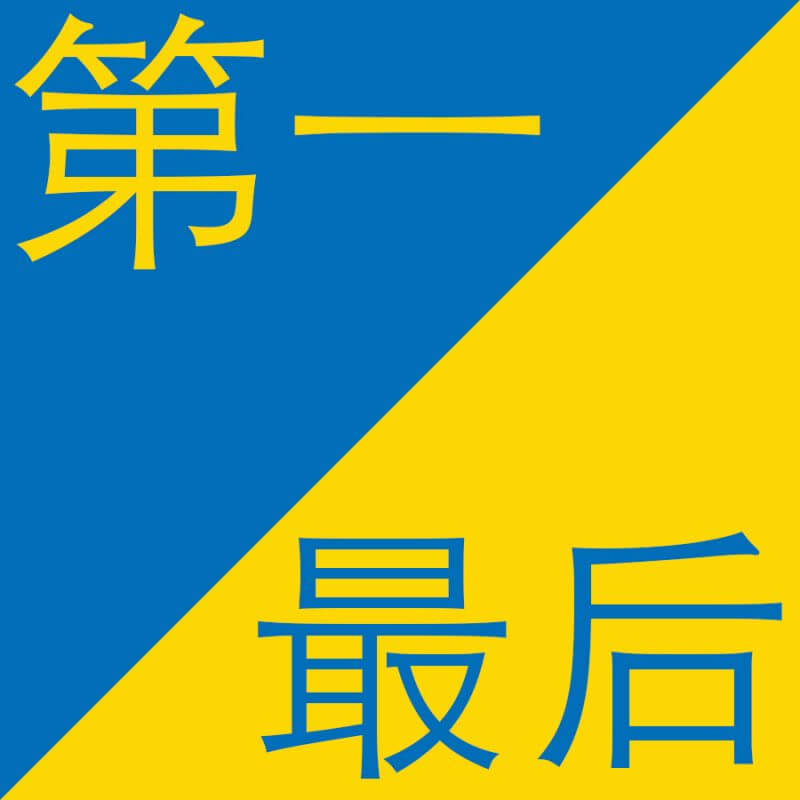
Get more opposites in Chinese.
Places in Chinese
| Vocabulary | Characters | Pinyin |
|---|---|---|
| France | 法国 | fà guó |
| America | 美国 | měi guó |
| Brazil | 巴西 | bā xī |
| Egypt | 埃及 | āi jí |
| South Africa | 南非 | nán fēi |
| Japan | 日本 | rì běn |
| India | 印度 | yìn dù |
| Phuket | 普吉岛 | pǔ jí dǎo |
| London | 伦敦 | lún dūn |
| New York | 纽约 | niǔ yuē |
Play
See our full list of places in Chinese.
Plants in Chinese
| Chinese Vocabulary | Characters | Pinyin |
|---|---|---|
| Daisy | 雏菊花 | chújú huā |
| Cactus | 仙人掌 | xiānrénzhǎng |
| Rose | 玫瑰 | méiguī |
| Sunflower | 向日葵 | xiàngrìkuí |
| Lavender | 薰衣草 | xūnyīcǎo |
| Lotus | 莲花 | liánhuā |
| Iris | 鸢尾花 | yuānwěi huā |
| Orchid | 兰花 | lánhuā |
| Lily | 百合 | bǎihé |
| Bamboo | 竹子 | zhúzi |
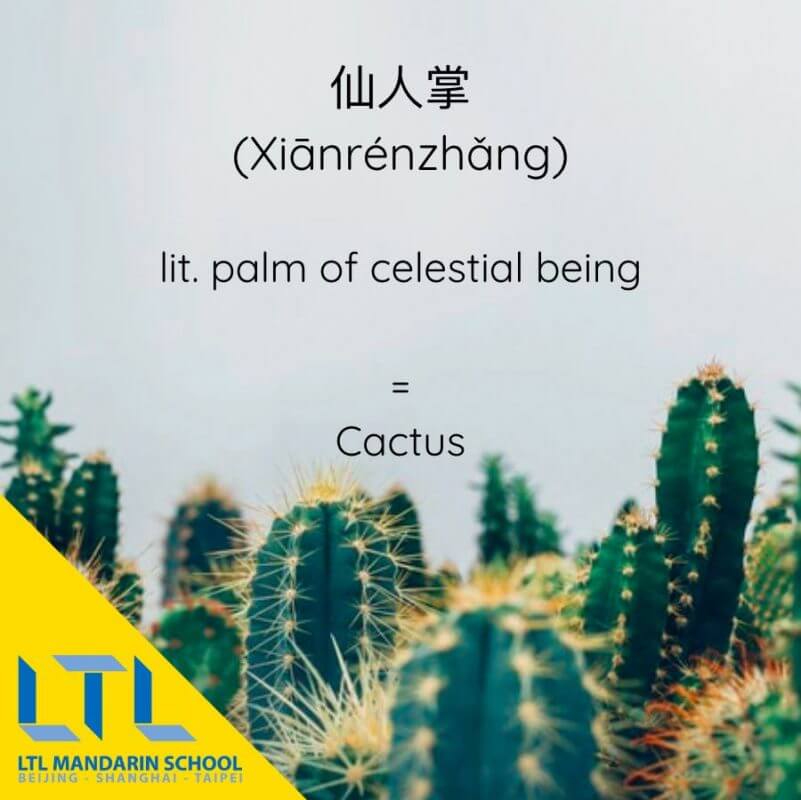
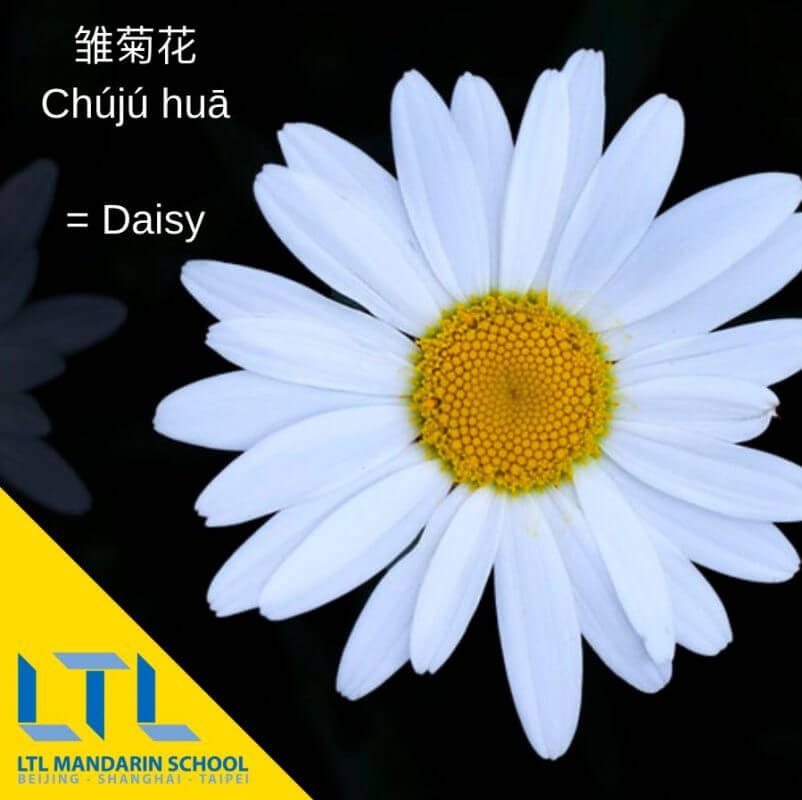
Discover more plants in Chinese.
Chinese Vocabulary: Questions
| Vocabulary | Characters | Pinyin |
|---|---|---|
| Who | 谁 | shéi |
| What | 什么 | shén me |
| Why | 为什么 | wèi shén me |
| Where | 哪里 | nǎ lǐ |
| Which | 哪个 | nǎ ge |
| When | 什么时候 | shén me shí hou |
| How | 怎么 | zěn me |
| What’s your name? | 您叫什么名字 | nín jiào shénme míngzi? |
| Where do you live? | 您住在哪里? | nín zhù zài nǎ lǐ? |
| Do you like China? | 您喜欢中国吗? | nín xǐ huan zhōng guó ma? |
Find all the questions in Chinese.
Days, Months and Seasons in Chinese
| Vocabulary | Characters | Pinyin |
|---|---|---|
| Monday | 星期一 | xīng qī yī |
| Sunday | 星期天 | xīng qī tiān |
| January | 一月 | yī yuè |
| December | 十二月 | shí èr yuè |
| Summer | 夏天 | xià tiān |
| Winter | 冬天 | dōng tiān |
| Morning | 早晨 | zǎo chén |
| Night | 夜晚 | yè wǎn |
| Today | 今天 | jīn tiān |
| Tomorrow | 明天 | míng tiān |
Learn more days months and seasons in Chinese.
Shapes in Chinese
| Vocabulary | Characters | Pinyin |
|---|---|---|
| Shape | 形状 | xíng zhuàng |
| Triangle | 三角形 | sān jiǎo xíng |
| Square | 方形 | fāng xíng |
| Circle | 圆形 | yuán xíng |
| Rectangle | 矩形 | jǔ xíng |
| Pentagon | 五角形 | wǔjiǎoxíng |
| Octagon | 八角形 | bā jiǎoxíng |
| Sphere | 球形 | qiú xíng |
| Cone | 锥体 | zhuī tǐ |
| Cube | 立方体 | lì fāng tǐ |
Play
Get all the shapes in Chinese.
Chinese Vocabulary: Shopping
| Vocabulary | Characters | Pinyin |
|---|---|---|
| Appliances | 家电 | jiādiàn |
| Home | 居家 | jūjiā |
| Digital | 数码 | shùmǎ |
| Cars | 汽车 | qìchē |
| Toys | 玩具 | wánjù |
| Entertainment | 娱乐 | yúlè |
| Beauty | 美妆 | měi zhuāng |
| Personal care | 个护 | gè hù |
| Jewellery | 饰品 | shìpǐn |
| Furniture | 家具 | jiājù |
Discover all the shopping in Chinese.
Shower in Chinese
| Chinese Vocabulary | Characters | Pinyin |
|---|---|---|
| To bathe | 洗澡 | xǐzǎo |
| To shower | 淋浴 | línyù |
| Shampoo | 洗发水 | xǐfàshuǐ |
| Conditioner | 护发素 | hùfàsù |
| Body Wash | 沐浴露 | mùyùlù |
| Hair dryer | 吹风机 | chuīfēngjī |
| Towel | 毛巾 | máojīn |
| Face wash | 洗面奶 | xǐmiànnǎi |
| Moisturizer | 护肤霜 | hùfūshuāng |
| Soap | 肥皂 | féizào |
Find more vocabulary for the shower in Chinese.
Space in Chinese
| Vocabulary | Characters | Pinyin |
|---|---|---|
| Sun | 太阳 | tài yáng |
| Mercury | 水星 | shuǐ xīng |
| Venus | 金星 | jīn xīng |
| Earth | 地球 | dì qiú |
| Space | 太空 | tài kōng |
| Asteroid | 小行星 | xiǎo xíng xīng |
| Black Hole | 黑洞 | hēi dòng |
| Comet | 彗星 | huì xīng |
| Galaxy | 银河系 | yín hé xì |
| Moon | 月亮 | yuè liang |

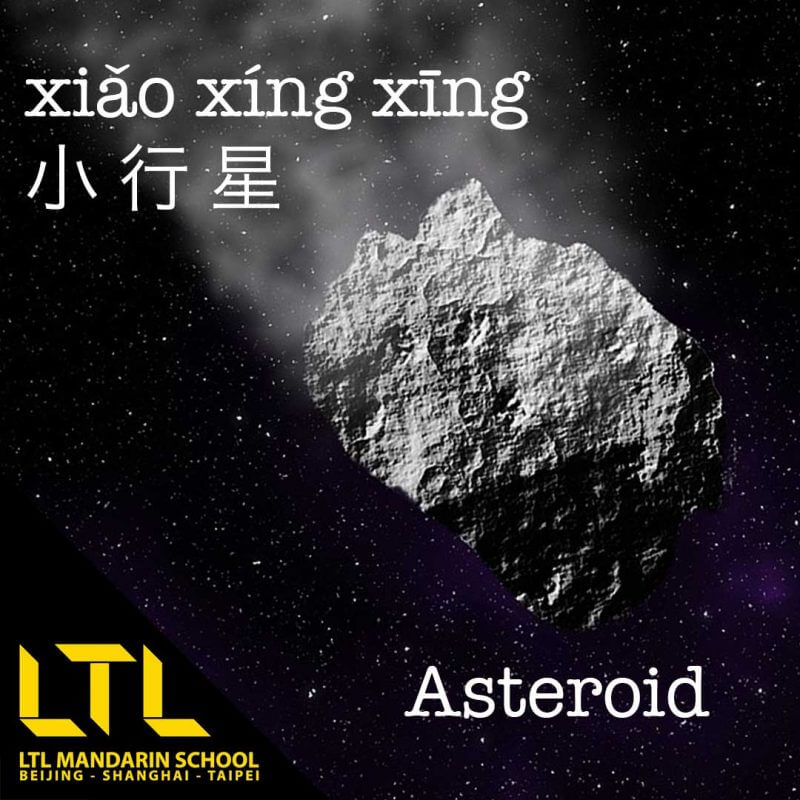
Learn all about space in Chinese.
Chinese Vocabulary: Sports
| Vocabulary | Characters | Pinyin |
|---|---|---|
| Fan | 球迷 | qiú mí |
| Match | 球赛 | qiú sài |
| Table Tennis | 乒乓球 | pīngpāng qiú |
| Basketball | 篮球 | lánqiú |
| Cricket | 板球 | bǎn qiú |
| Football | 足球 | zúqiú |
| Run | 跑步 | pǎobù |
| Swim | 游泳 | yóu yǒng |
| Skiing | 滑雪 | huáxuě |
| Boxing | 拳击 | quánjí |
Play
Get more sports in Chinese.
Stationery in Chinese
| Chinese Vocabulary | Characters | Pinyin |
|---|---|---|
| Pen | 笔 | bǐ |
| Pencil | 铅笔 | qiānbǐ |
| School Bag | 书包 | shūbāo |
| Calculator | 计算器 | jìsuànqì |
| Eraser | 橡皮 | xiàngpí |
| Pencil Sharpener | 转笔刀 | zhuànbǐdāo |
| Scissors | 剪刀 | jiǎndāo |
| Sticky Tape | 胶带 | jiāodài |
| Paperclip | 曲别针 | qūbiézhēn |
| Stapler | 订书机 | dìngshūjī |
Play
See our full list of stationery in Chinese.
Subway (sandwiches) in Chinese
| Vocabulary | Characters | Pinyin |
|---|---|---|
| Subway | 赛百味 | sài bǎiwèi |
| Bread | 面包 | miàn bāo |
| 6 Inch | 6寸的 | liù cùn de |
| Footlong | 12寸的 | shíèr cùn de |
| Veggie Delight | 缤纷蔬菜 | bīnfēn shūcài |
| Ham and Chinese | 西式火腿 | xīshì huǒtuǐ |
| Lettuce | 生菜 | shēng cài |
| Tomato | 生菜 | shēng cài |
| Honey Mustard | 蜜汁芥末酱 | mì zhī jiè mò jiàng |
| Mayonnaise | 蛋黄酱 | dàn huáng jiàng |
Play
Discover more about ordering a Subway in Chinese.
Chinese Vocabulary: Superheroes
| Chinese Vocabulary | Characters | Pinyin |
|---|---|---|
| Superhero | 超级英雄 | chāo jí yīng xióng |
| Spiderman | 蜘蛛侠 | zhīzhū xiá |
| Superman | 超人 | chāorén |
| Batman | 蝙蝠侠 | biānfúxiá |
| Joker | 小丑 | xiǎochǒu |
| Wonder Woman | 神奇女侠 | shénqí nǚxiá |
| Green Lantern | 绿灯侠 | lǜdēng xiá |
| Thor | 雷神托尔 | léi shén tuō ěr |
| Captain America | 美国队长 | měiguó duì zhǎng |
| Iron Man | 钢铁侠 | gāngtiě xiá |
Find all the superheroes in Chinese.
Therapy in Chinese
| Vocabulary | Characters | Pinyin |
|---|---|---|
| Therapy | 治疗 | zhìliáo |
| Therapist | 治疗师 | zhìliáo shī |
| Psychology | 心理学 | xīnlǐ xué |
| Speech Therapy | 言语干预 | yán yǔ gān yù |
| Occupational Therapy | 职能辅导 | zhí néng fǔ dǎo |
| Behavioural Therapy | 行为辅导 | xíng wéi fǔ dǎo |
| Physiotherapy | 物理疗法 | wùlǐ liáofǎ |
| Therapy Dog | 治疗狗 | zhìliáo gǒu |
| Assessment | 评估 | píng gū |
| Behaviour | 行为 | xíng wéi |
Learn more about therapy in Chinese.
Time in Chinese
| Vocabulary | Characters | Pinyin |
|---|---|---|
| Clock | 时钟 | shí zhōng |
| 1 O’Clock | 一点 | yī diǎn |
| Hour | 小时 | xiǎo shí |
| Minute | 分钟 | fēn zhōng |
| Second | 秒 | miǎo |
| Morning | 早上 | zǎo shang |
| Today | 今天 | jīntiān |
| Yesterday | 昨天 | zuótiān |
| Tomorrow | 明天 | míngtiān |
| Wednesday | 星期三 | xīngqī sān |
Get all the time in Chinese.
Chinese Vocabulary: Transport
| Vocabulary | Characters | Pinyin |
|---|---|---|
| Transport | 交通运输 | jiāotōng yùnshū |
| Ambulance | 救护车 | jiùhù chē |
| Bicycle | 自行车 | zìxíng chē |
| Bus | 公共汽车 | gōnggòng qìchē |
| Car | 车 | chē |
| Motorbike | 摩托车 | mótuō chē |
| Taxi | 出租车 | chūzū chē |
| Tram | 电车 | diànchē |
| Van | 面包车 | miànbāo chē |
| Helicopter | 直升机 | zhíshēng jī |
Play
Discover more ways to talk about transportation in Chinese.
Vegetables in Chinese
| Chinese Vocabulary | Characters | Pinyin |
|---|---|---|
| Asparagus | 芦笋 | lú sǔn |
| Broccoli | 西兰花 | xī lán hu |
| Cabbage | 卷心菜 | juǎnxīncài |
| Carrot | 胡萝卜 | hú luó bo |
| Cauliflower | 菜花 | cài huā |
| Celery | 芹菜 | qín cài |
| Cucumber | 黄瓜 | huáng guā |
| Eggplant | 茄子 | qié zi |
| Garlic | 大蒜 | dà suàn |
| Mushrooms | 蘑菇 | mó gu |
Play
Find more vegetables in Chinese.
Verbs in Chinese
| Vocabulary | Characters | Pinyin |
|---|---|---|
| Agree | 同意 | tóng yì |
| Answer | 回答 | huí dá |
| Cook | 做饭 | zuò fàn |
| Cry | 哭 | kū |
| Dig | 挖 | wā |
| Find | 找到 | zhǎo dào |
| Give | 给 | gěi |
| Have | 有 | yǒu |
| Hear | 听见 | tīng jiàn |
| Laugh | 笑 | xiào |
Learn all the verbs in Chinese.
Viruses in Chinese
| Chinese Vocabulary | Characters | Pinyin |
|---|---|---|
| Hospital | 医院 | yīyuàn |
| Doctor | 医生 | yīshēng |
| Nurse | 护士 | hùshì |
| Pharmacy | 药店 | yàodiàn |
| Pharmacist | 药剂师 | yàojì shī |
| Medicine | 药 | yào |
| Symptom | 症状 | zhèngzhuàng |
| Unwell | 不舒服 | bù shūfu |
| Fever | 发烧 | fā shāo zhuangzheng |
| Headache | 头疼 | tóuténg |
Find out how to talk about viruses in Chinese.
Chinese Vocabulary Quiz
Ready to test yourself? 100 questions all relating to what we taught you above.
Strap in, buckle up… and see how good your Chinese Vocabulary really is…!
BONUS CONTENT | Interested in other languages too? Why not check out our list of the 100 most common Korean words to learn and the most commonly used Kanji in Japanese too.
Chinese Vocabulary – FAQ’s
How can I improve my Chinese vocabulary?
Some ways to improve your Chinese vocabulary is to use personal images while studying the new vocab.
For example, learn dog (狗 gǒu) while looking at an image of your dog.
Next recall what you have previously learnt (not review), recalling information will help kick your brain into gear.
Finally, try using a spaced repetition system to review words right at the moment you’re about to forget them!
What are the basic Chinese words?
The fundamentals of basic Chinese words can all be found in HSK 1 and 2.
After passing HSK 2 you would be able to communicate in simple and routine tasks.
This would include very basic personal and family information, shopping, local geography, employment and more. Discover all the levels of the HSK levels and the Chinese words in each category.
How do you say vocabulary in Chinese?
Vocabulary in Chinese is: 词汇 cíhuì
Can I learn Chinese online?
Absolutely!
There are plenty of resources to learn Chinese online. However one of the best ways to ensure you are pronouncing the Chinese tones correctly is to get immediate feedback from an online Chinese tutor.
Want more from LTL?
Want to learn Chinese from the comfort of you own home? Then Online Chinese lessons might be the thing for you.
If you wish to hear more from LTL Mandarin School why not join our mailing list.
We give plenty of handy information on learning Chinese, useful apps to learn the language and everything going on at our LTL schools! Sign up below and become part of our ever growing community!
Read More
-
4 Classic Chinese Novels 📚 Discover The 四大名著
-
HSK vs HSKK // What’s The Difference?
-
Your Complete Guide to Game of Thrones 🎬 in Chinese
16 comments
-
[…] being in here I have been doing some Chinese practice, just learning vocab through the app Memrise. However, for other people I think Chinese classes might be a really good […]
-
Really really good list, best I’ve seen yet, cheers
-
Thanks a lot Brian, took some time, but all worth it!
-
-
Love it! Any downloadable PDFs?
-
-
Fantastico
-
😎
-
-
Awesome compilation! Thanks. Now, do you have any lists for all things Chinese, such as martial arts, tea, caligtaphy, dao, and the like? That would be the best ever!
-
Excellent ideas Jimena, Tea we have but the others we’ll try and prepare something soon for you. Sign up to our newsletter and you’ll know exactly when we release them!
Tea Customs in China (with vocabulary) 👉👉👉 https://ltl-beihai.com/tea-customs-in-china/
-
-
To certain extend manageable. Good.
-
Very informative
-
Chinese quiz.
-
[…] written in traditional Chinese. This can happen when using Mandarin Chinese, or when using Mandarin Chinese vocabulary and grammar is significantly different than that of Mandarin. Furthermore, it may be interesting to […]
-
[…] Each one follows logically from the last, allowing you to easily build a bank of useful grammar and vocabulary. […]
-
Best list,congratulation
-
Thanks Brian
-


